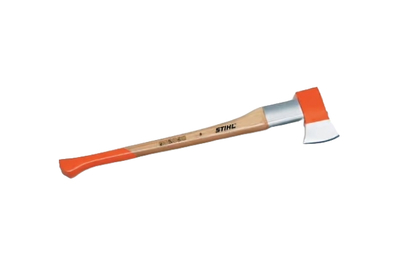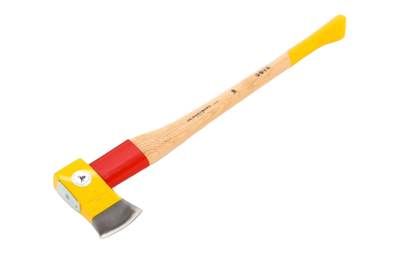As the old saying goes, firewood warms you three times: when you split it, when you stack it, and when you burn it. But with the wrong tool, your physically exhilarating, meditative wood-splitting session can go from warm to overheated, as you sweat and swear in a frustrated effort to split the next knotty log.
After a summer testing nine splitting axes on a variety of hard, soft, seasoned, and freshly fallen wood, I found that the Stihl Pro Splitting Axe was the best tool for the job.
Top pick
None of the other axes split like the Stihl Pro Splitting Axe. The beefy, 5.5-pound, wedge-shaped head split nearly everything I tried with it, from seasoned hardwoods to damp softwoods. The 32-inch handle is very comfortable—thin down at the grip area with a nice palm swell at the end—but up at the axe head, it swells to a thicker size, boosting strength at an axe’s weakest point. Adding to the durability is an overstrike protector, a thick metal collar that encircles the handle just below the axe head. We’ve seen this Stihl axe retail for $100 to $140, which puts it on the higher end of splitting-axe pricing, but after using it and comparing it against the competition, we think it’s clearly worth the investment. When it came time to wrap up a testing session and get my own splitting done, this is the axe I reached for.
Runner-up
If the Stihl axe is not available or if you prefer yellow over orange, we recommend the Gedore Ochsenkopf OX 648 H-2508. This model is the exact same tool as the Stihl axe, just with a different-colored head and handle. Gedore owns Ochsenkopf, the German manufacturer of the axe, which also co-brands it to Stihl. We recommend getting whichever one is less expensive.
Budget pick
Another nice option is the Council Tool 5-Pound SB Splitting Axe. Although it doesn’t match the Stihl and Gedore axes in their ability to bust apart wood, this 36-inch-long wood-handled axe is an efficient splitter with an extremely comfortable handle. The added length makes it generally safer, and the straight handle adds to its accuracy, so it’s a good option for first-time splitters. But at the same time, the head is weighted in such a way that it’s also built for more advanced splitting techniques. It’s lighter than the Stihl axe, too, but keep in mind that it has no overstrike protection, so you’ll likely have to replace the handle at some point during the life of the tool. Usually priced around $80, this model is one of the least expensive axes we looked at.
Best for
We also like the Husqvarna S2800 Composite Splitting Axe. Shorter than our other three picks, this Husqvarna model is a more portable option, appropriate for a camping trip or for work deep in the woods. But it’s also a proficient-enough wood splitter to serve as a primary splitting axe. It has a composite handle, which gives it immunity to the effects of water and weather. (I once forgot a composite splitting axe under a snow bank for an entire winter, and when spring came, it was fine.) This Husqvarna axe has some nice added features, including an overstrike protector and a pointed blade edge that you can use to maneuver a log around. The downside of the S2800, as with all composite axes, is that once the tool breaks, it’s finished—you can’t just re-handle the axe head. The good news, though, is that the S2800 carries a limited lifetime warranty.








